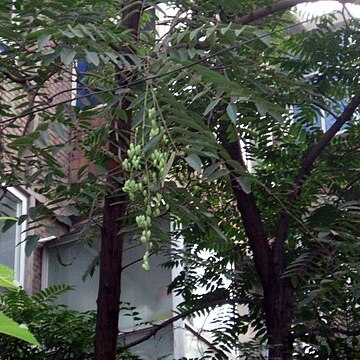Tree to 40 m; bole to 20 m and girth to 150 cm, buttressed. Bark grey to dark brown, fissured; inner bark pink to red, fibrous; sapwood cream, fibrous; smelling strongly of garlic and pepper when cut. Leaves 32–120 cm long, usually 8–20-jugate; rachides glabrous to pilose, often reddish; petioles 5.5–20 cm long, glabrous to pilose. Leaflets narrowly lanceolate to linear-lanceolate, serrate or serrulate, rarely entire, 11–22 by 3– 5.6 cm, glabrous to pilose, especially on the midribs and veins, club-shaped glandular hairs conspicuous on upper midrib areas and junctions between leaf rachides and petio-lules, apex acuminate, base asymmetric; petiolules 3–9 mm long, glabrescent. Inflores-cences up to 1 m, pendent, rachides glabrescent, pilose or villous with short appressed or spreading staple hairs; pedicels c. 0.5 mm, glabrescent to pilose. Flowers 3.5–4.5 mm long. Calyx cupulate, 1–1.5 mm long, glabrous externally; sepals 0.5–1.1 by 0.6– 1.75 mm, margins ciliate. Petals white or flushed pink, 2.8–4.2 by 1.1–2.9 mm, glabrous externally, margins non-ciliate. Androgynophore 2.5–4 mm long, glabrous. Staminodes always present, usually 5, sometimes 1–4, 0.75–1.75 mm long, glabrous. Filaments 1.3–1.75 mm long (male flowers), 1–1.5 mm long (female flowers), glabrous. Anthers 0.8–1.2 mm long, 0.5–0.75 mm broad. Antherodes 0.3–0.8 mm long, 0.3– 0.5 mm broad, apices apiculate, sometimes extended. Disk 1–1.5 mm diam., orange, glabrous. Ovary 1.6–2.25 mm diam., glabrous; locules to 6-ovulate. Style 1.1–1.5 mm long, 0.5 mm broad (male), 0.5–0.8 mm long, 0.3–0.4 mm broad (female), glabrous; stylehead 0.5–1 mm diam. Capsule 15–30 mm long; columella 12–29 mm long, 6–11 mm broad, convex; valves reddish to dark brown, 15–30 by 4–7 mm, elenticellate and smooth to punctate with small (0.3–0.5 mm diam.) scattered lenticels. Seeds winged at one end, 8–16 by 3.5–6.2 mm; seed body 8–10 by 1.7–4 mm.
A deciduous tree. It grows 20-30 m tall. The trunk is 60-100 cm across. The trunk is straight with few branches. The leaves are 60 cm long. There are 10-24 leaflets along the stalks. The leaves have teeth along the edge. The leaflets are red-bronze when young and turn yellow before they fall. The flowers are cream and small. They have a scent. They occur in drooping panicles. These are 30 cm long. The fruit is a woody brown capsule. It is 3 cm long. There are several winged seeds.


